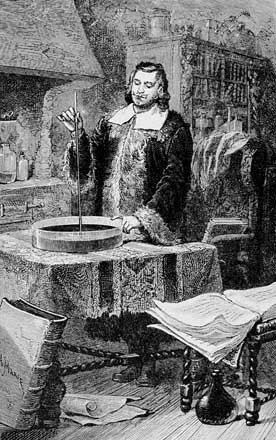Barometer





Barometer is an instrument used to measure atmospheric pressure. It plays a crucial role in meteorology, the science that studies the atmosphere and its phenomena, especially with respect to weather and weather forecasting. The concept of the barometer was first developed in the 17th century, and since then, it has undergone significant advancements, leading to various types of barometers being used today.
History[edit]
The invention of the barometer is credited to the Italian scientist Evangelista Torricelli in 1643. Torricelli, a student of Galileo Galilei, demonstrated that air has weight by using a tube filled with mercury. He inverted the tube into a dish of mercury and observed that the mercury level dropped, leaving a vacuum at the top. This experiment led to the creation of the first mercury barometer and proved the existence of atmospheric pressure.
Types of Barometers[edit]
There are primarily two types of barometers: mercury and aneroid.
Mercury Barometers[edit]
A Mercury barometer consists of a glass tube that is closed at one end and open at the other, filled with mercury. The open end is submerged in a mercury reservoir. The height of the mercury column in the tube changes as the atmospheric pressure varies, with higher pressure pushing more mercury up the tube and lower pressure allowing it to drop. Mercury barometers are known for their accuracy and were widely used until concerns about mercury's toxicity led to the development of safer alternatives.
Aneroid Barometers[edit]
Aneroid barometers, invented by Lucien Vidie in 1843, do not use mercury. Instead, they contain a small, flexible metal box called an aneroid cell. Changes in atmospheric pressure cause the cell to expand or contract. This movement is magnified by a mechanism and displayed on a dial, making it easier to read. Aneroid barometers are safer and more portable than mercury barometers but can be less accurate unless regularly calibrated.
Applications[edit]
Barometers have a wide range of applications, from meteorology to aviation. In meteorology, they are used to measure atmospheric pressure, which helps in forecasting weather and identifying changes in weather patterns. A sudden drop in atmospheric pressure, for example, can indicate the approach of a storm. In aviation, barometers are used to determine altitude, as atmospheric pressure decreases with an increase in altitude.
Digital Barometers[edit]
With advancements in technology, digital barometers have become common. These instruments use electronic sensors to measure atmospheric pressure and often include features such as temperature and humidity sensors, making them versatile tools for weather observation and forecasting.
Conclusion[edit]
The barometer is a vital instrument in understanding and predicting weather. From its historical mercury-based design to modern digital versions, it has evolved significantly over the centuries. Despite the development of new technologies, the basic principle discovered by Torricelli remains at the heart of how barometers function, demonstrating the enduring importance of this tool in meteorology and beyond.

This article is a Musical instrument-related stub. You can help WikiMD by expanding it!
Ad. Transform your life with W8MD's Budget GLP-1 injections from $75


W8MD offers a medical weight loss program to lose weight in Philadelphia. Our physician-supervised medical weight loss provides:
- Weight loss injections in NYC (generic and brand names):
- Zepbound / Mounjaro, Wegovy / Ozempic, Saxenda
- Most insurances accepted or discounted self-pay rates. We will obtain insurance prior authorizations if needed.
- Generic GLP1 weight loss injections from $75 for the starting dose.
- Also offer prescription weight loss medications including Phentermine, Qsymia, Diethylpropion, Contrave etc.
NYC weight loss doctor appointmentsNYC weight loss doctor appointments
Start your NYC weight loss journey today at our NYC medical weight loss and Philadelphia medical weight loss clinics.
- Call 718-946-5500 to lose weight in NYC or for medical weight loss in Philadelphia 215-676-2334.
- Tags:NYC medical weight loss, Philadelphia lose weight Zepbound NYC, Budget GLP1 weight loss injections, Wegovy Philadelphia, Wegovy NYC, Philadelphia medical weight loss, Brookly weight loss and Wegovy NYC
|
WikiMD's Wellness Encyclopedia |
| Let Food Be Thy Medicine Medicine Thy Food - Hippocrates |
Medical Disclaimer: WikiMD is not a substitute for professional medical advice. The information on WikiMD is provided as an information resource only, may be incorrect, outdated or misleading, and is not to be used or relied on for any diagnostic or treatment purposes. Please consult your health care provider before making any healthcare decisions or for guidance about a specific medical condition. WikiMD expressly disclaims responsibility, and shall have no liability, for any damages, loss, injury, or liability whatsoever suffered as a result of your reliance on the information contained in this site. By visiting this site you agree to the foregoing terms and conditions, which may from time to time be changed or supplemented by WikiMD. If you do not agree to the foregoing terms and conditions, you should not enter or use this site. See full disclaimer.
Credits:Most images are courtesy of Wikimedia commons, and templates, categories Wikipedia, licensed under CC BY SA or similar.
Translate this page: - East Asian
中文,
日本,
한국어,
South Asian
हिन्दी,
தமிழ்,
తెలుగు,
Urdu,
ಕನ್ನಡ,
Southeast Asian
Indonesian,
Vietnamese,
Thai,
မြန်မာဘာသာ,
বাংলা
European
español,
Deutsch,
français,
Greek,
português do Brasil,
polski,
română,
русский,
Nederlands,
norsk,
svenska,
suomi,
Italian
Middle Eastern & African
عربى,
Turkish,
Persian,
Hebrew,
Afrikaans,
isiZulu,
Kiswahili,
Other
Bulgarian,
Hungarian,
Czech,
Swedish,
മലയാളം,
मराठी,
ਪੰਜਾਬੀ,
ગુજરાતી,
Portuguese,
Ukrainian